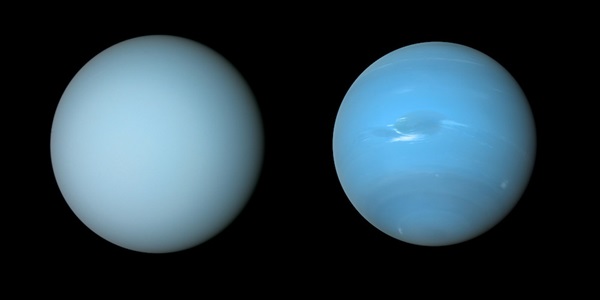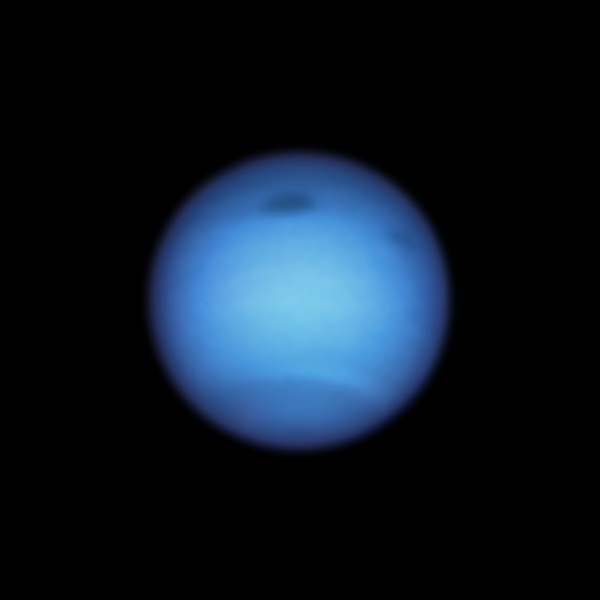Key Takeaways:
- Uranus and Neptune, despite their visual similarity, exhibit a slight color difference: Uranus appears cyan, while Neptune is azure. This difference has been attributed to variations in atmospheric haze.
- A new atmospheric model suggests that Uranus's slower atmospheric dynamics hinder the dissipation of haze, resulting in a lighter blue hue compared to Neptune. If haze were absent, both planets would appear nearly identical in color.
- Both planets share similar sizes, masses, and atmospheric compositions (primarily hydrogen, helium, and methane), but differ in their atmospheric activity; Neptune's more active atmosphere is more efficient at clearing haze through methane snow precipitation.
- The model also proposes a connection between haze layers and the formation of dark spots observed on Neptune, potentially caused by variations in the deepest haze layer.
To the untrained eye, it might be difficult to immediately differentiate between Uranus and Neptune. Yes, the color of Uranus is often described as cyan, while the color of Neptune is frequently cited as azure. But no matter your nomenclature, it’s hard to deny the ice giants look quite similar at a quick glance. And that’s not entirely surprisingly when you consider that similar components make up both worlds.
For years, researchers have struggled to develop a model that accurately explains the slight color difference between Uranus and Neptune. But now, scientists believe they might have finally cracked the code to why our solar system’s two most distant planets are slightly different shades of blue.
The new model suggests that while haze accumulates in the atmospheres of both planets, Uranus’ sluggish atmosphere is bad at dispelling that haze, giving it a slightly lighter shade of blue than Neptune. The results were published May 23 in the Journal of Geophysical Research: Planets.
The true twins of the solar system
While Venus is often called Earth’s sister world, the two rocky planets are a far cry from twins. Uranus and Neptune, on the other hand, are incredibly similar.
For starters, Neptune and Uranus are basically the same size: Both worlds are just over 30,000 miles (50,000 kilometers) wide, and Uranus is only a measly 900 miles (1,500 kilometers) larger in diameter than Neptune. Their masses are also about the same: Uranus is some 14 times the mass of Earth, while Neptune is about 17 times the mass of Earth.
Being ice giants, both planets are primarily composed of elements heavier than hydrogen and helium, such as oxygen, carbon, nitrogen, and sulfur. Although the tippy-tops of both worlds’ atmospheres are predominately hydrogen, helium, and methane, their mantles are chock-full of water, ammonia, and (again) methane.
From their sizes to their masses to their atmospheric compositions, the solar system’s ice giants share many properties with one another. So, it’s no surprise that their differing color schemes have long left astronomers scratching their heads.
Modeling shades of blue
Although the ice giants’ compositions are nearly the same, the new research describes how Uranus has more haze in its upper atmosphere than Neptune does, which gives Uranus a slightly whiter tint. According to the new model, if neither planet had any such haze, they would be almost exactly same shade of blue.
Unlike past models, the new model looked at the ice giants through a wide range of wavelengths, corresponding to numerous atmospheric layers. It also moved the haze particles deeper into the planets’ clouds, which, before now, researchers thought was a region that only contained layers of methane and hydrogen sulfide ices.
Both Uranus and Neptune are thought to condense methane ice in their hazy upper clouds, with the methane falling to deeper layers of their atmospheres as snow. However, Neptune’s more active atmosphere means this methane snow falls more efficiently than it does on Uranus, giving it a bolder blue color than its twin.
The model doesn’t just stop at the haze, either. It also explains Neptune’s aptitude for developing dark spots. Like Jupiter’s Great Red Spot, researchers believe that these enormous spots are likely storms in Neptune’s — and occasionally Uranus’ — lower atmosphere. According to the latest model, either a darkening or clearing of the deepest layer of haze could be responsible for creating these shadowy features.
While the new model is promising, it doesn’t hold all the answers to the mysteries of these distant giants.
The first and last time a spacecraft visited our solar system’s most distant planets was Voyager 2 in the 1980s. Ever since, scientists have been clamoring to return. And now that Uranus was recently labeled as one of the priorities for NASA in the next decade, odds are good for a future mission that will unlock the secrets of the ice giants.












